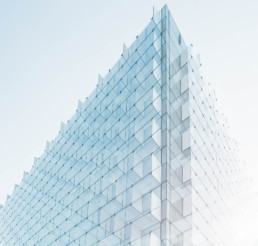Constructing smart buildings and eco-offices
Traditional construction methods create traditional spaces, but there is a better approach. By employing the latest innovations in construction you give rise to smarter buildings and more environmentally friendly offices. Overall efficiency – both of the build project and resulting space – is improved, reducing costs and the use of vital resources. So why isn’t everyone constructing smart buildings?
As devices to convert your home into a ‘smart home’ continue to take over, there seems to be relatively little interest in using the latest innovations in building projects – particularly offices. But, with numerous benefits to the building owner, business users and even the occupants that will work in the finished space, we believe the smart revolution is coming.
What is a smart office or building?
Traditional offices are built to maintain a relative degree of comfort with regular maintenance. Smart offices are designed to adapt to requirements with relatively little maintenance. For example, they use automated systems to turn systems on and off as required, rather than running at a baseline level in the background all the time. So what does that look like?
Well, your traditional office likely has the lights on constantly throughout the day, even in areas that are not in use, and possibly at weekends too. Electricity supply, heating, devices – everything is ready to go when it’s needed. Smart offices, however, shut down systems that aren’t in use, conserving energy and therefore resources such as fossil fuels and money. They also give the end-user more control over their environment. This control, and the resulting comfort, are important for productivity, but are hard to achieve in a traditional office with just two settings: on or off.
And with these systems comes the ability to monitor, track, and analyze data that inform future strategies for enhancing the workspace. But there is another way to be ‘smart’, too. Some buildings are designed without the need for these automated systems. If you have a natural ventilation loop built-in and make use of natural light, the requirements for active ventilation and lighting can be greatly reduced, or negated altogether; this is also smart.
Why aren’t there more smart buildings?
Smart buildings require a whole new approach to the design-and-build process – and it’s no wonder, when traditional methods of office design still produce spaces that create the same amount of waste as they did two decades ago. By including the waste that will be generated in the planning phase, we can ensure we produce less of it.
I believe that this is due to the fact that our offices are not our homes; it’s not our own money, and decisions are ultimately made by a team of people – diffusing the responsibility to make eco-friendly choices and making it less likely for a radical thinker to come along and ‘rock the boat’. It is time for all of us to stop making excuses – costs, time etc – and start acting as leaders to create better spaces for our people and our planet.
Saj Rahman, Founder and CEO of Maple People
This industry generally relies on regulations and legislation that is passed as a ‘reaction’. But we don’t believe in waiting for a disaster to occur before we start to make a positive change. At Maple People, we believe in proactivity and consideration towards the occupants of these spaces and, indeed, the inhabitants of the planet as a whole.
Examples of smart buildings
The Edge, The Netherlands
The Edge is an office building that outcompetes all others when it comes to sustainability. For a start, the solar panels on the outside of the structure generate more energy than the building itself uses. With nearly 30,000 sensors inside the building, it is possible to ensure every inch of the building expends only as much energy as is required; empty sections of the office are shut down, unneeded lights turn off automatically, cleaning only occurs when it is required and natural ventilation overrides the need for air conditioning.
The general aim when building The Edge was to try anything with a return-on-investment of less than 10 years. The building is a showcase of the latest innovations in construction, and an example of the cost-saving benefits of investing slightly more in the initial outlay in order to reap the rewards; especially in something as long-lived as a working building.
Passive House
Passive House – or PassivHaus – is an architectural movement that spread around northern Europe in the 1990s and has since extended across the globe. This is at the opposite end of the ‘smart’ spectrum to The Edge, as the Passive House buildings do not require sensors to activate or deactivate systems as needed. Passive House buildings are heated, ventilated and cooled by the careful design of the structure instead of requiring active systems to carry out those tasks. With 30% of energy consumption used in heating and cooling of buildings in the EU, these smart designs are of huge benefit both to the occupants (and their wallets) and the environment.
These houses feature all kinds of innovations, such as solar space heating and ground cooling, all enhanced by optimising the orientation of the building to make the most of natural light and internal sources of heat, such as appliances. The initial additional cost of creating a passive house instead of a traditional building is recovered in savings within a decade.
The requirement for insulation and air-tightness (aside from the passive forced ventilation system) leads to a temperature-controlled, quiet, and comfortable environment for the occupants. The Passive House movement creates high-spec living environments in an ethical and sustainable manner, without requiring a vastly bigger budget than traditional homes.
Smart buildings: smart future
At Maple People we are dedicated to this idea of building ‘smart’. We invest our profits back into research and development so that we can be at the forefront of the smart revolution. Our customers don’t have to choose between aesthetics, affordability and ethicality; they can have it all.
The commercial industry (build and usage) is responsible for 40% of the world’s energy demand, and it is here that the wealth lies and where change of a substantial magnitude can happen. Unlike general technology, the construction industry has not changed with the times. It is now that Maple People have begun our journey to change the way we construct. We must look to each other as individuals to drum up the race for change. We are the consumers; we have a choice to make about the mark we leave on this world.



